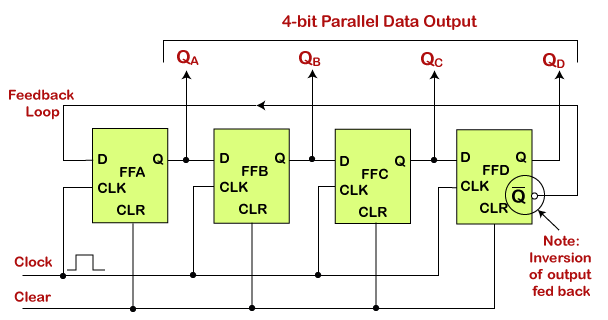Verilog Johnson CounterA Johnson counter is a digital circuit with a series of flip flops connected in a feedback manner. Verilog Johnson counter is a counter that counts 2N states if the number of bits is N. The circuit is a special type of shift register where the last flip flop's complement output is fed back to the first flip flop's input. This is almost similar to the ring counter with a few extra advantages. The Johnson counter's main advantage is that it only needs half the number of flip-flops compared to the standard ring counter, and then it's modulo number is halved. So an n-stage Johnson counter will circulate a single data bit, giving a sequence of 2n different states and can therefore be considered a mod-2n counter. The inverted output Q of the last flip-flop is connected back to the input D of the first flip-flop. Below is the circuit diagram for a 4-bit Johnson counter: 
This inversion of Q before it is fed back to input D causes the counter to count differently. Instead of counting through a fixed set of patterns just like the normal ring counter such as for a 4-bit counter, "0001"(1), "0010"(2), "0100"(4), "1000"(8) and repeat. The Johnson counter counts up and then down as the initial logic "1" passes through it to the right replacing the preceding logic "0". A 4-bit Johnson ring counter passes blocks of four logic "0" and then four logic "1" thereby producing an 8-bit pattern. As the inverted output Q is connected to the input D, this 8-bit pattern continually repeats. For example, "1000", "1100", "1110", "1111", "0111", "0011", "0001", "0000". This is demonstrated in the following table:
As well as counting or rotating data around a continuous loop, ring counters can also be used to detect or recognize various patterns or number values within a set of data. By connecting simple logic gates such as the OR gates to the flip-flops' outputs, the circuit can be made to detect a set number or value. Standard 2, 3 or 4-stage Johnson Ring Counters can also be used to divide the clock signal frequency by varying their feedback connections, and divide-by-3 or divide-by-5 outputs are also available. For example, a 3-stage Johnson Ring Counter could be used as a 3-phase, 120-degree phase shift square wave generator by connecting to the data outputs at A, B and NOT-B. The standard 5-stage Johnson counter, such as the commonly available CD4017, is generally used as a synchronous decade counter/divider circuit. Other combinations, such as the smaller 2-stage circuit, which is also called a Quadrature Oscillator or Generator, can be used to produce four individual outputs that are each 90 degrees out-of-phase for each other to produce a 4-phase timing signal. ExampleTestbench And the output looks like: ncsim> run T=0 out=xxxx T=10 out=0001 T=50 out=0000 T=70 out=1000 T=90 out=1100 T=110 out=1110 T=130 out=1111 T=150 out=0111 T=170 out=0011 T=190 out=0001 T=210 out=0000 T=230 out=1000 T=250 out=1100 T=270 out=1110 T=290 out=1111 T=310 out=0111 Simulation complete via $finish(1) at time 330 NS + 0
Next TopicBidirectional Shift Register
|
 For Videos Join Our Youtube Channel: Join Now
For Videos Join Our Youtube Channel: Join Now
Feedback
- Send your Feedback to [email protected]
Help Others, Please Share










